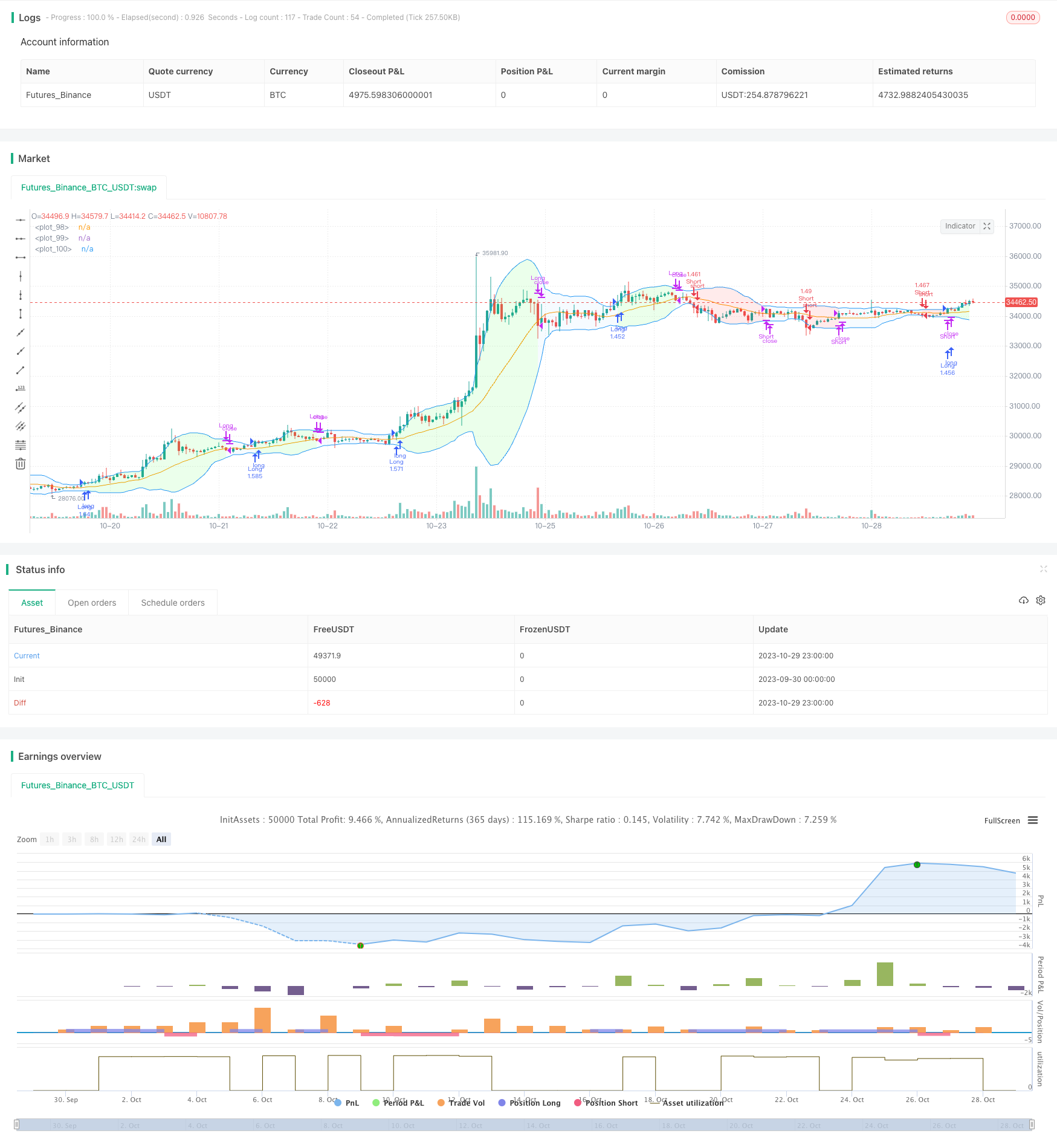
概述
这是一个基于布林带通道的反转型震荡趋势策略。它利用布林带上下通道作为趋势判断,并在价格接近通道边界时寻找反转机会入场。
策略原理
该策略使用布林带指标作为主要技术指标。布林带由n日移动平均线及其上下波动范围构成,布林带上轨=n日移动平均线 + m×n日标准差,布林带下轨=n日移动平均线 - m×n日标准差。其中n和m为参数。
当价格接近上轨时,表示当前处于上升趋势,但是可能会触顶反转;当价格接近下轨时,表示当前处于下跌趋势,但是可能会触底反转。这时候如果有效突破布林带上下轨,则可能开始反转。
本策略的具体交易规则如下:
当收盘价大于布林带上轨时,做多入场;当收盘价小于布林带下轨时,做空入场。
止盈止损以n日移动平均线为信号。当多单收盘价下破n日均线时止盈出场;当空单收盘价上破n日均线时止损出场。
采用固定交易量,每次交易数值固定。
采用固定比率资金管理法,设定固定盈亏比率和订单调整幅度。当实现固定比率盈利时按固定幅度增加仓位,当亏损时减少仓位。
优势分析
该策略具有以下优势:
使用布林带通道判断趋势方向,采取逆势交易策略,在价格可能反转的时间点入场,避开大部分震荡,提高胜率。
移动平均线作为止盈止损信号较为可靠,可以锁定大部分利润。
固定交易量策略简单易行,不需要复杂计算。
固定比率资金管理策略可以通过仓位调整扩大盈利同时控制风险。
风险分析
该策略也存在一定风险:
布林带判断产生错误信号的概率存在,可能在趋势中反向做单亏损。
移动平均线滞后性可能导致止盈不够充分。
固定交易量无法根据市场情况调整仓位,存在仓位过大过小的问题。
固定比率资金管理方法扩大仓位幅度较大,可能导致亏损扩大。
对策:优化布林带参数,提高信号准确率;结合其他指标判断趋势;适当缩小固定仓位大小;降低固定比率资金管理的仓位调整幅度。
优化方向
该策略可以从以下几个方面进行优化:
优化布林带的参数,如调整n值和m值,提高布林带通道判断准确性。
增加其他指标判断,如MACD,KD等,避免布林带错误信号。
将固定交易量调整为动态交易量,根据市场情况灵活调整仓位。
降低固定比率资金管理法的仓位调整幅度,优化资金曲线。
添加止损策略,如移动止损、区间突破止损等,进一步控制风险。
进行参数优化,自动优化参数组合,寻找最佳参数对策略进行优化。
总结
该策略整体是一个较为典型的布林带反转策略。它利用布林带判断趋势反转点,配合移动平均线设置止盈止损,固定交易量和固定比率资金管理控制风险。相比传统布林带策略,该策略作为一个反转策略,在理论上可以避开部分震荡,提高盈利概率。但由于布林带和移动平均线等指标本身存在缺陷,实际运用时仍需要进一步优化,才能使策略参数化并减少交易风险。
/*backtest
start: 2023-09-30 00:00:00
end: 2023-10-30 00:00:00
period: 1h
basePeriod: 15m
exchanges: [{"eid":"Futures_Binance","currency":"BTC_USDT"}]
*/
// This source code is subject to the terms of the Mozilla Public License 2.0 at https://mozilla.org/MPL/2.0/
// © gsanson66
//This strategy uses the well-known Bollinger Bands Indicator
//@version=5
strategy("BOLLINGER BANDS BACKTESTING", shorttitle="BB BACKTESTING", overlay=true, initial_capital=1000, default_qty_type=strategy.cash, default_qty_value=950, commission_type=strategy.commission.percent, commission_value=0.18)
//----------------------------------------FUNCTIONS---------------------------------------//
//@function Displays text passed to `txt` when called.
debugLabel(txt, color) =>
label.new(bar_index, high, text = txt, color=color, style = label.style_label_lower_right, textcolor = color.black, size = size.small)
//@function which looks if the close date of the current bar falls inside the date range
inBacktestPeriod(start, end) => (time >= start) and (time <= end)
//---------------------------------------USER INPUTS--------------------------------------//
//Technical parameters
bbLength = input.int(defval=20, minval=1, title="BB Length", group="Technical Parameters")
mult = input.float(defval=2, minval=0.1, title="Standard Deviation Multipler", group="Technical Parameters")
smaLength = input.int(defval=20, minval=1, title="SMA Exit Signal Length", group="Technical Parameters")
//Money Management
fixedRatio = input.int(defval=400, minval=1, title="Fixed Ratio Value ($)", group="Money Management")
increasingOrderAmount = input.int(defval=200, minval=1, title="Increasing Order Amount ($)", group="Money Management")
//Backtesting period
startDate = input(title="Start Date", defval=timestamp("1 Jan 2020 00:00:00"), group="Backtesting Period")
endDate = input(title="End Date", defval=timestamp("1 July 2024 00:00:00"), group="Backtesting Period")
//----------------------------------VARIABLES INITIALISATION-----------------------------//
strategy.initial_capital = 50000
//Exit SMA
smaExit = ta.sma(close, smaLength)
//BB Calculation
basis = ta.sma(close, bbLength)
dev = mult * ta.stdev(close, bbLength)
upperBB = basis + dev
lowerBB = basis - dev
//Money management
equity = strategy.equity - strategy.openprofit
var float capital_ref = strategy.initial_capital
var float cashOrder = strategy.initial_capital * 0.95
//Backtesting period
bool inRange = na
//------------------------------CHECKING SOME CONDITIONS ON EACH SCRIPT EXECUTION-------------------------------//
//Checking if the date belong to the range
inRange := true
//Checking performances of the strategy
if equity > capital_ref + fixedRatio
spread = (equity - capital_ref)/fixedRatio
nb_level = int(spread)
increasingOrder = nb_level * increasingOrderAmount
cashOrder := cashOrder + increasingOrder
capital_ref := capital_ref + nb_level*fixedRatio
if equity < capital_ref - fixedRatio
spread = (capital_ref - equity)/fixedRatio
nb_level = int(spread)
decreasingOrder = nb_level * increasingOrderAmount
cashOrder := cashOrder - decreasingOrder
capital_ref := capital_ref - nb_level*fixedRatio
//Checking if we close all trades in case where we exit the backtesting period
if strategy.position_size!=0 and not inRange
strategy.close_all()
debugLabel("END OF BACKTESTING PERIOD : we close the trade", color=color.rgb(116, 116, 116))
//-----------------------------------EXIT SIGNAL------------------------------//
if strategy.position_size > 0 and close < smaExit
strategy.close("Long")
if strategy.position_size < 0 and close > smaExit
strategy.close("Short")
//----------------------------------LONG/SHORT CONDITION---------------------------//
//Long Condition
if close > upperBB and inRange
qty = cashOrder/close
strategy.entry("Long", strategy.long, qty)
//Short Condition
if close < lowerBB and inRange
qty = cashOrder/close
strategy.entry("Short", strategy.short, qty)
//---------------------------------PLOTTING ELEMENT----------------------------------//
plot(smaExit, color=color.orange)
upperBBPlot = plot(upperBB, color=color.blue)
lowerBBPlot = plot(lowerBB, color=color.blue)
fill(upperBBPlot, lowerBBPlot, title = "Background", color=strategy.position_size>0 ? color.rgb(0, 255, 0, 90) : strategy.position_size<0 ? color.rgb(255, 0, 0, 90) : color.rgb(33, 150, 243, 95))